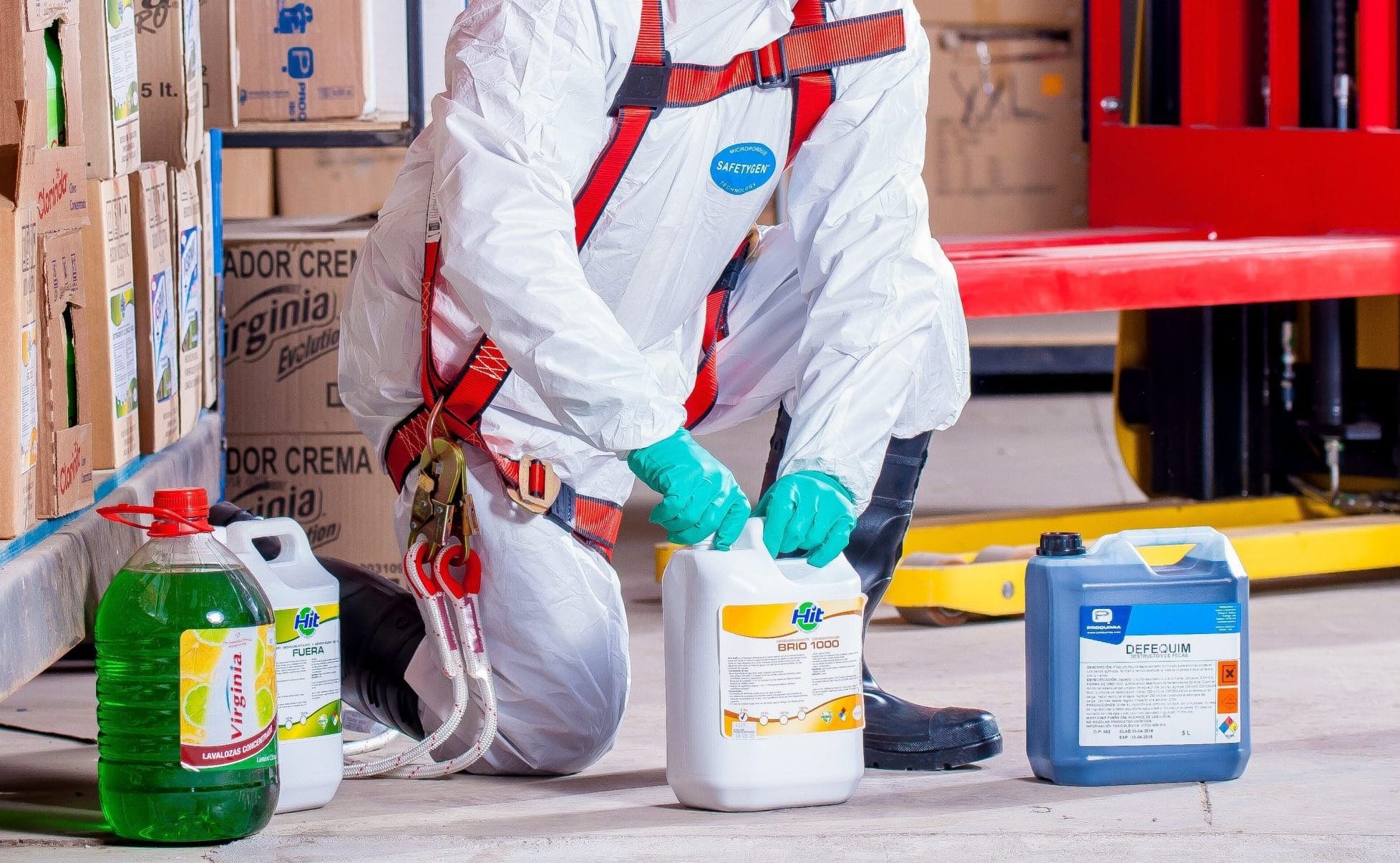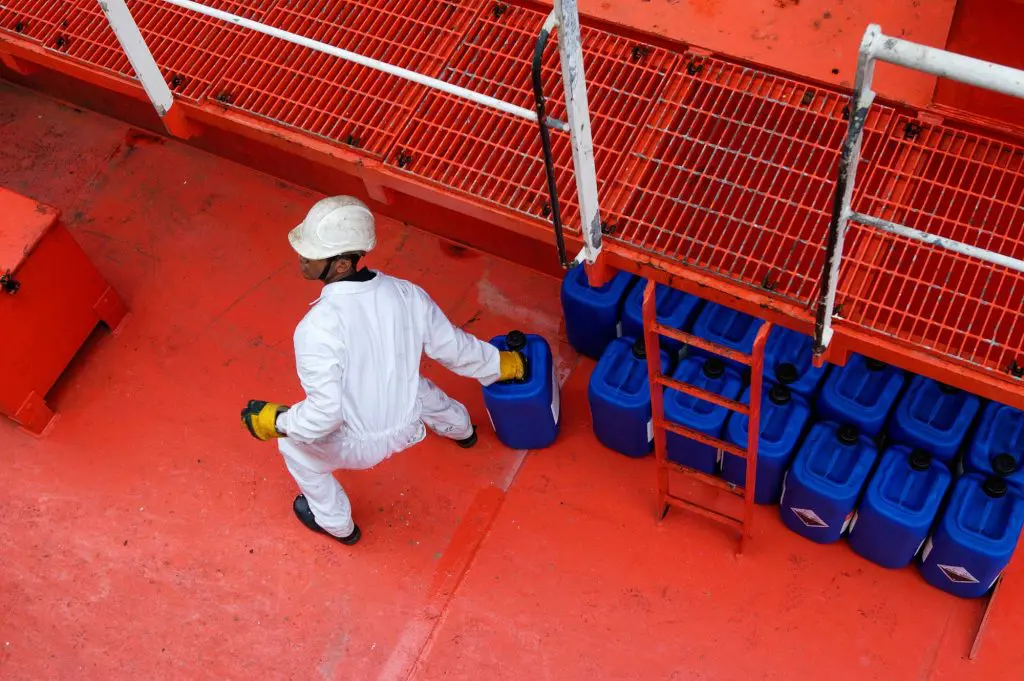Hazardous materials are chemical substances which, if released or misused, can pose a threat to people’s health or the environment. Emergencies can happen during production, storage, transportation, use, or disposal.
You are at risk when chemicals are used unsafely or released in harmful amounts where you live, work, or play. A hazardous material incident can happen anywhere, and you need to be prepared in case an incident occurs near you.
Ammonia is the most common chemical spilled in Wisconsin. Natural gas is the second most common chemical released in the state, followed by hydrochloric acid.
Wisconsin Emergency Management contracts and manages 22 Regional Hazardous Materials Response Teams in the state.
Classes of Hazardous Materials
Explosives
Explosives that most people are familiar with include dynamite, gun powder, and fireworks.
Gases
These can include ammonia, propane, spray paints, helium, chlorine, or carbon monoxide.
Flammable Liquids
Examples include gasoline, acetone, ethanol, and lacquer-based paint.
Flammable Solids
Examples include match sticks, Sterno, highway flares, oily rags, or magnesium fire starters.
Oxidizing Substances and Organic Peroxide
Examples include hydrogen peroxide and silver nitrate.
Toxic and Infectious Substances
Examples include cyanides, lead compounds, phenol, some pesticides, biological samples, and clinical waste.
Radioactive Materials
Examples include medical isotopes, uranium, plutonium, cobalt, and spent nuclear fuel.
Corrosive Substances
Examples include sodium hydroxide, hydrochloric acid, or sulfuric acid.
Miscellaneous Hazardous Materials/Dangerous Goods and Articles
Examples include ammonium-nitrate fertilizers, asbestos, any battery-powered vehicles or equipment, and dry ice.
Protecting Yourself…
…Before a Hazardous Materials Incident
- Build an emergency supply kit, with the addition of duct tape, scissors and plastic sheeting to cover doors, windows and vents.
- Make a family emergency plan.
- Know how to operate your home’s ventilation system.
- Identify an above-ground shelter room with as few openings as possible.
- Contact local emergency management office to find out what chemicals are stored in your community. Businesses that store hazardous materials are required to report the quantity and type of material.
…During a Hazardous Materials Incident
- Get away. You should get away from the area of the chemical release or spill. Once you are away, clean any chemical exposure off your body and get help as soon as you can.
- If you are inside. Get outside into the fresh air and quickly move as far away as possible. Take any pets with you.
- If outside. Get away from the chemical release area as far as you can and uphill if possible. Chemicals stay close to the ground.
- In general, try to go at least a half mile (usually 8-10 city blocks) from the danger area.
- Do not touch any spilled liquids. If possible, cover mouth with a cloth or mask while leaving the area
- Stay away from victims until the hazardous material has been identified.
- Disposing of contaminated clothing. Quickly remove clothing that came into contact with hazardous materials. Cut off clothing rather than pulling it over your head.
- Put clothes into a plastic bag while avoiding contaminated areas of clothing. Use tongs or other items to handle contaminated clothing.
- Any item used to dispose of clothing should also be placed inside the bag. Seal the first plastic bag inside a second plastic bag.
- Alert officials of your contamination bag for proper disposal.
- Asked to stay indoors or shelter-in-place? Sometimes the best way to stay safe during a hazardous materials release or spill is to get inside a building or vehicle and stay there until authorities instruct it is safe to leave that location.
- Get inside a building. Bring loved ones and pets inside. Do not allow pets to go outside the shelter until the danger has passed.
- Seek shelter in an internal room. Close and lock all exterior doors and windows. Close vents, fireplace dampers and as many interior doors as possible.
- Listen to officials for further instructions.
- If told to seal the room to keep outside air from coming in:
- Turn off things that bring in outside air, such as air conditioners and ventilation systems, or set ventilation systems to 100 percent recirculation so no outside air is drawn into the building.
- Seal gaps under and around the following areas with wet towels, plastic sheeting, duct tape, wax paper or aluminum foil:
- Doorways and windows
- Air conditioning units
- Bathroom and kitchen exhaust fans
- Stove and dryer vents with duct tape and plastic sheeting
- Take shallow breaths through a cloth or towel if gas or vapors could have entered the building.
- Avoid eating or drinking any food or water that may be contaminated.
- Once officials say the emergency is over, turn on fans and other systems that circulate air. Everyone should go outside until the building’s air has been exchanged with the now clean outdoor air.
- If outside when a hazardous materials incident occurs:
- Quickly decide what is the fastest way to find clean air. Move away immediately in a direction upwind of the source.
- If inside a vehicle, pull over and keep car windows and vents closed. Shut off the air conditioner and heater.
- Find the closest building to shelter-in-place.
- Asked to evacuate? Do so immediately and stay tuned to the radio or television for information on evacuation routes, temporary shelter locations, and evacuation procedures.
- If you have time, minimize contamination in the house by closing all windows, shutting all vents, and turning off attic fans.
- Take your pre-assembled emergency kit
- Remember to help neighbors that may need special assistance. These can include infants, elderly people, and those with access and functional needs.
…After a Hazardous Materials Incident
- Listen to local radio or television stations for the latest emergency information. Do not leave the safety of shelter to go outdoors, including to help others, until authorities say it is safe to do so. If you evacuated, return home only when authorities say it is safe.
- Follow decontamination instructions from local authorities.
- Seek medical treatment for unusual symptoms as soon as possible. Advise anyone who comes in to contact with you that you may have been exposed to a toxic substance.
- If you are affected by a chemical agent or hazardous substance and medical help is not immediately available, the best action is to decontaminate yourself and help others to do so if possible.
- How to decontaminate:
- Remove all clothing and other items in contact with your body.
- Cut off clothing normally removed over the head to avoid contact with the eyes, nose and mouth.
- Put contaminated clothing and items into a plastic bag and seal the bag.
- Remove eyeglasses or contact lenses. Put glasses in a pan of household bleach to decontaminate and then rinse with water and dry.
- Wash hands with soap and water. If helping someone decontaminate, immediately wash your hands and other exposed skin afterwards.
- Flush eyes with water.
- Gently wash face and hair with soap and thoroughly rinse with water.
- Remove all clothing and other items in contact with your body.
- How to decontaminate:
- Find out from local authorities how to clean up your land and property.
- Report any lingering vapors or other hazards to your local emergency services office.


